West Yorkshire
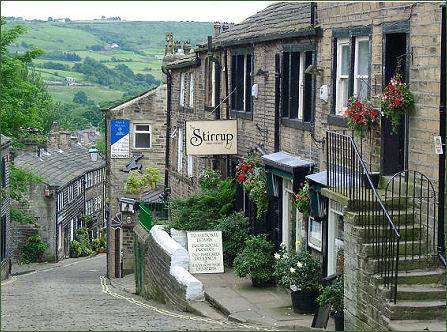 West Yorkshire became a county in 1974, by the Local Government Act 1972, and corresponds roughly to the core of the historic West Riding of Yorkshire.
West Yorkshire became a county in 1974, by the Local Government Act 1972, and corresponds roughly to the core of the historic West Riding of Yorkshire.
The area which is known as Bronte Country includes the Pennine hills to the west of the Bradford- Leeds conurbation, Kirklees and Calderdale. The bleak and often evocative landscape of of the region inspired the Bronte sisters, Charlotte, Emily and Anne, to write the classic novels which made them famous.
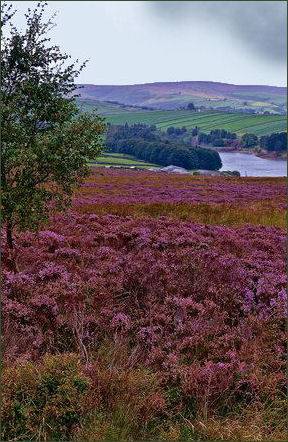 The town of Haworth, (left) situated above the Worth Valley in the Pennine moors, is chiefly famous for being home to the Bronte sisters, whose father was curate at the local church, but has much more to offer the visitor. The Bronte sisters were born in Thornton, to the west of Bradford, but arrived in Haworth in 1821 and wrote most of their famous works while living at Haworth Parsonage. The parsonage at Haworth was to remain the family's home for the rest of their lives. The town of Haworth's moorland setting had a profound influence on the famous books of Charlotte, Emily and Anne Bronte.
The town of Haworth, (left) situated above the Worth Valley in the Pennine moors, is chiefly famous for being home to the Bronte sisters, whose father was curate at the local church, but has much more to offer the visitor. The Bronte sisters were born in Thornton, to the west of Bradford, but arrived in Haworth in 1821 and wrote most of their famous works while living at Haworth Parsonage. The parsonage at Haworth was to remain the family's home for the rest of their lives. The town of Haworth's moorland setting had a profound influence on the famous books of Charlotte, Emily and Anne Bronte.
The church of St. Michael and All Angels at Haworth, of which Reverend Patrick Bronte was incumbent, dates mainly from the eighteenth century. The church was rebuilt after the deaths of the Bronte family, only the tower remains of the original building, which has bullet holes, a result of Mr Brontė's regular habit of firing a pistol at it each morning. Other buildings in the area associated with the Brontė family include the Red House Museum, situated on Oxford Road in Gomersal, which is a Grade II Listed 1830's cloth merchant's home which boasts connections with Charlotte Brontė. Charlotte visited the Red House frequently and featured it in her novel "Shirley". Now a museum, it features atmospheric period rooms, recreated gardens and exhibitions in the restored outbuildings.
Ponden Hall, which stands half a mile from the edge of Stanbury was reputedly the inspiration for Thrushcross Grange, the home of the Linton family, Edgar, Isabella, and Cathy, in Emily Brontė's novel 'Wuthering Heights'. The isolated, abandoned farm at Top Withens (right) on Haworth Moor is situated about 5 kilometres to the south-west of Haworth. The farmhouse, which stands at a height of 1,400 feet, is said to be the inspiration for the Earnshaw home in Emily Bronte's classic masterpiece 'Wuthering Heights', a tale of love and revenge on the Yorkshire Moors.
The city of Wakefield is situated on the River Calder and the eastern edge of the Pennine Hills. It lies 9 miles (14 km) to the southeast of Leeds Its name is thought to derive from "Waca's field". Other theories suggest it may have developed from the Anglo-Saxon word wacu, meaning "a watch or wake", and feld, an open field in which a wake or festival was held. Wakefield is referred to in the Domesday Book of 1086 as Wachefeld. The ruins of Sandal Castle overlook the River Calder at Sandal Magna, a suburb of the city. This was ssite of the Battle of Wakefield fought on 30 December, 1460, where Richard, Duke of York, the Yorkist claimant to the throne was defeated and killed by the forces of Margaret of Anjou during the Wars of the Roses. Wakefield Cathedral, or the Cathedral Church of All Saints was originally the city's parish church and is set at the heart of Wakefield on a hill on Kirkgate. It is one of Yorkshire's greatest churches. The Chantry Chapel of St Mary the Virgin at Wakefield is one of only three surviving bridge chapels in England and, with the bridge, is a scheduled ancient monument.
The historic market town of Pontefract is one of the 'Five Towns' in the district of Wakefield. Its name derives from the Latin words pons meaning 'bridge' and fractus which means 'broken'. The ruins of Pontefract Castle stands on a rock to the east Pontefract above All Saints Church. Little survives today of what was once one of the mightiest and most feared castle in Yorkshire. Parts of the curtain wall can be seen and some of the excavated inner walls. Parts of Piper Tower's postern gate and the foundations of a chapel are the oldest remains. The ruins of the Round Tower or keep stand atop the eleventh century mound. Chambers excavated into the rock in the inner bailey possibly indicate the site of the old hall. King Richard II (1367-1400) was probably murdered within the castle after deposed by John of Gaunt's son, Henry IV, first king of the House of Lancaster. Pontefract Hermitage is a medieval building located 50 feet beneath the old Southgate entrance to the General Infirmary. The hermitage was discovered in October 1854 by workmen laying a new sewer. The retreat, which dates to 1386, comprises of two sandstone chambers on different levels. From the lower chamber a spiral staircase descends to a well.
The highly attractive West Yorkshire market town of Holmfirth, known locally as 'Little Hollywood', is the setting for the BBC's long running comedy series Last of the Summer Wine. Thousands of tourists visit the town every year to see the locations familiar in the series, such as Sid's Cafe (pictured left) and Nora Batty's famous Steps and to enjoy the superb surrounding scenery across the Holme Valley.
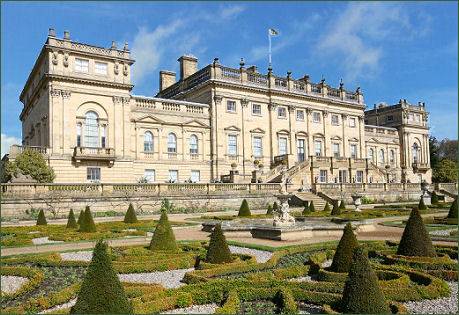 The county has its fair share of stately homes, magnificent Harewood House (pictured right) is situated at Harewood near Leeds and was designed by York born architect John Carr and completed by Robert Adam. The house was constructed between 1759 and 1771 for Edwin Lascelles, 1st Baron Harewood and is a member of Treasure Houses of England, a marketing consortium for ten of the foremost historic homes in the country.
The magnificent State rooms are furnished by Thomas Chippendale, and contain a collection of paintings by masters of the Italian Renaissance, family portraits by Reynolds, Hoppner, Lawrence, works by Reynolds, Titian, El Greco and Picasso and modern art collected by the 7th Earl and Countess. The house also contains a fine collection of Sčvres china.
The county has its fair share of stately homes, magnificent Harewood House (pictured right) is situated at Harewood near Leeds and was designed by York born architect John Carr and completed by Robert Adam. The house was constructed between 1759 and 1771 for Edwin Lascelles, 1st Baron Harewood and is a member of Treasure Houses of England, a marketing consortium for ten of the foremost historic homes in the country.
The magnificent State rooms are furnished by Thomas Chippendale, and contain a collection of paintings by masters of the Italian Renaissance, family portraits by Reynolds, Hoppner, Lawrence, works by Reynolds, Titian, El Greco and Picasso and modern art collected by the 7th Earl and Countess. The house also contains a fine collection of Sčvres china.
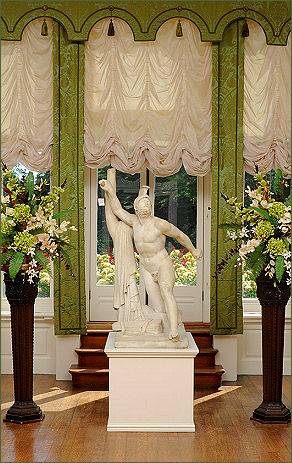 Seventeenth century East Riddlesden Hall stands on a small plateau overlooking a bend in the River Aire on its way downstream from the town of Keighley. The hall, which is reputed to be haunted, features the Great Hall, a large barn-like space with a huge fireplace and a fine collection of pewter, two Yorkshire Rose windows, a walled garden and the ruined Starkie wing. A hiding place for Catholic priests was installed during the sixteenth century. The hall contains much locally made period furniture, including a carved and canopied seventeenth century cupboard which was described by Emily Bronte in "Wuthering Heights".There is also a medieval tithebarn in the grounds.
Seventeenth century East Riddlesden Hall stands on a small plateau overlooking a bend in the River Aire on its way downstream from the town of Keighley. The hall, which is reputed to be haunted, features the Great Hall, a large barn-like space with a huge fireplace and a fine collection of pewter, two Yorkshire Rose windows, a walled garden and the ruined Starkie wing. A hiding place for Catholic priests was installed during the sixteenth century. The hall contains much locally made period furniture, including a carved and canopied seventeenth century cupboard which was described by Emily Bronte in "Wuthering Heights".There is also a medieval tithebarn in the grounds.
Lotherton Hall (pictured left) is a charming Edwardian country house near Aberford, Leeds. The hall was extensively reconstucted during the Victorian and Edwardian periods by Colonel Frederick Gascoigne, the oldest parts of the present building are believed to be the Regency core of the main house which is now the Boudoir and Medal Room. The hall houses a superb collection of objets d'art, which have been accumulated since the eighteenth century and are now on display to the public. On the ground floor of the north wing visitors can view the restored Servants' Rooms. There are several, mainly local exhibitions featured in the Servants' Hall each year.
Oakwell Hall in the village of Birstall is furnished as a family home of the 1690s and offers visitors a real insight into a post-English Civil War household. The hall was built was John Batt to the usual post-medieval plan of a central hall block flanked by crosswings. A recarved stone dated 1583 probably indicates the date of construction. Occupying the site of a twelfth century Augustinian priory, Nostell Priory is situated at Nostell, near to Wakefield. The priory was dedicated to St Oswald, an Anglo-Saxon King of Northumbria). After flourishing for over 400 years the priory was surrendered to Henry VIII in 1540, during the Dissolution of the Monasteries. Construction of the present house commenced in 1733, and the furniture, furnishings and decorations made for the house remain in situ. Imposing Temple Newsam, a Tudor-Jacobean house, which has been described as "the Hampton Court of the North" and beautifully restored to its former glory. The house lies to the east of the city of Leeds.
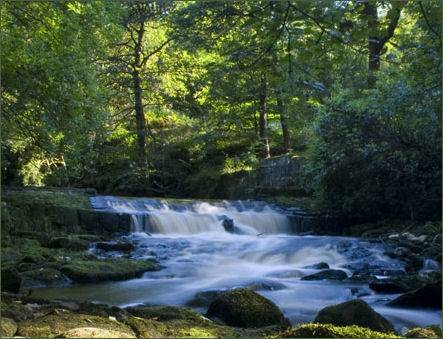 The ruins of Kirkstall Abbey, the most complete set of Cistercian ruins in Britain, are situated in Kirkstall, to the north-west of Leeds city centre. The abbey is set in a pleasant public park on the north bank of the River Aire. The picturesque ruins have been drawn and painted by artists such as J.M.W. Turner, Thomas Girtin and John Sell Cotman. Kirklees Priory was a Cistercian nunnery which occupied the site of the present-day Kirklees Park, at Clifton near Brighouse in West Yorkshire, the private 750-acre estate, lies between the M62 and Wakefield Road. The priory is connected with the medieval legend of Robin Hood, England's outlaw hero. The upper room of the gatehouse is where the legendary Robin Hood is said to have breathed his last.
The ruins of Kirkstall Abbey, the most complete set of Cistercian ruins in Britain, are situated in Kirkstall, to the north-west of Leeds city centre. The abbey is set in a pleasant public park on the north bank of the River Aire. The picturesque ruins have been drawn and painted by artists such as J.M.W. Turner, Thomas Girtin and John Sell Cotman. Kirklees Priory was a Cistercian nunnery which occupied the site of the present-day Kirklees Park, at Clifton near Brighouse in West Yorkshire, the private 750-acre estate, lies between the M62 and Wakefield Road. The priory is connected with the medieval legend of Robin Hood, England's outlaw hero. The upper room of the gatehouse is where the legendary Robin Hood is said to have breathed his last.
Beautiful lkley Moor forms part of Rombalds Moor, which roughly bordered by the spa town of Ilkley in the north, Silsden in the west, Keighley in the south and Menston in the east. The moor, which rises to 402 metres (1,319 feet) above sea level, is famous as the inspiration for Yorkshire's unofficial national anthem 'On Ilkla Moor Baht 'at' and is also a Site of Special Scientific Interest due to its upland habitat for ground-nesting birds. Two rock climbing areas, Rocky Valley and Ilkley Quarry are situated to the north, where the moor drops steeply towards the village of Ben Rhydding. Ilkley Quarry is the site of the famous "Cow and Calf", a large rock formation consisting of an outcrop and boulder, also known as Hangingstone Rocks. Legend states that there was once also a "bull", but that was quarried for stone.
Otley Chevin Forest Park is a highly attractive wooded ridge on the south side of Wharfedale which overlooks the town of Otley, 9 miles to the north-west of Leeds. The highest point of the wooded escarpment, known as Surprise View, rises to a height of 925 feet (282 metres) and provides superb views over Otley and Wharfedale. A car park is provided, a cross has been erected there every Easter since 1969. Large outcrops of rock litter the upper slopes of the Chevin which are popular with climbers. The ridge has a number of footpaths. The Leeds link to the Dales Way crosses it, as does the Ebor Way. There is also an Orienteering course in the forest park, maps are available from the local tourist office.
Hardcastle Crags (above right) is a beautiful wooded valley in the South Pennines which covers more than 160 hectares (400 acres) and lies approximately 2 miles (3.2 km) to the north of the town of Hebden Bridge. There are deep ravines, tumbling streams, glorious waterfalls traversed by more than 15 miles (24km) of footpaths. The woodlands are particularly lovely in late Spring when the bluebells are in bloom. The Marsden Moor Estate, a large expanse of rugged moorland situated in the Pennines, lies between the conurbations of West Yorkshire and Greater Manchester. The estate covers some 2,429 ha (5,685 acres) and forms the most northerly section of the Peak District National Park, the Pennine Way crosses over the moor. The landscape is made up of unspoilt valleys, peaks and crags and has been used as a water catchment area since the Victorian era and contains several reservoirs. March Hill, near March Haigh reservoir is one of Britain's primary Mesolithic sites, where flint tools have been excavated and hearths uncovered from beneath the peat. A small bronze-age cemetery has been discovered at Pule Hill, which provides dramatic views over the moor. Eastergate Bridge, an ancient packhorse bridge was once used to carry goods over the Pennines to market.
